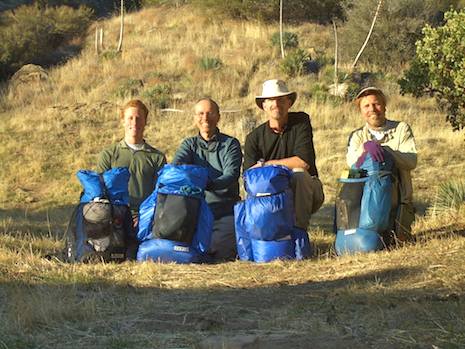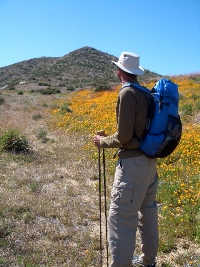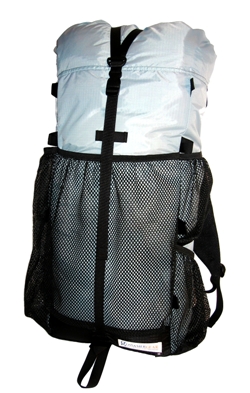Going Ultralight – The Pack
Your Choice of Pack Will Determine How Serious Your Are About Going UL

“If it’s so much fun to go ultra light then how come everyone’s not already doing it?” A friend asks. “I mean, who’d want to carry around a 40 pound pack when they can do it for half the weight?”
Good question.
Part of it, I think, is that the gear hasn’t migrated down to the outlets yet. Go to SportMart and you’ll have a hard time fining a pack that weighs less than 5 pounds let alone one that is under two pounds. Manufacturers such as North Face or Gregory or Osprey have a heavy investment in big packs that generate a healthy profit.
Home Grown Companies. Another reason is that the ones who are making UL gear are basically startup companies with a few employees and relatively modest sales. Even if the larger distributors such as REI wanted to carry their gear most of the UL manufacturers wouldn’t be able to handle the volume needed to make it work.
Most of them are like Gossamer Gear’s Glen Van Peski who began designing gear to make his own backpacking trips a lot more fun. Glen had done some backpacking as a youth, but didn’t get involved again until his eldest son Brian joined the Boy Scouts.

Glen went down to the local REI and loaded up on the standard backpacking gear. After a year or two of backpacking with the troop, his friend Read Miller, then the Scoutmaster, read Ray Jardine’s book (Beyond Backpacking, AdventureLore Press, revised 2000) on ultralight backpacking, and started to implement some of the ideas. With Read’s example, Glen also started to pare down his pack weight.
Within a year Glen had designed his first backpack which he named the “G1” and subsequent versions (G2, G3, G4) improved on the initial design. The first of these that were sold commercially were sewn by Glen’s wife Francie and several other women in the neighborhood but by 2002 he realized he needed to have them made commercially to keep up with the growing demand for his packs.
After finding a manufacturer in the Seattle area Glen committed to an order of 50 of his newest pack design, the G4. Word spread quickly on the Internet, and G4 orders increased rapidly. Glen’s son Brian put together a website to take orders and several years later, to accommodate new products, the website was completely revamped by Glen’s sister Brooke.
By this time, the business was consuming a large part of Glen’s life but still wasn’t contributing financially to his family’s fortunes. Rather than raise prices, Glen decided to increase the number of products offered to generate some synergy, and create enough volume to allow automated systems to be put into place. By 2004, Gossamer Gear had been born, the name chosen for the sense of what the word gossamer represented – something light, almost floating in air – the embodiment of what Glen’s ultralight gear was designed to be.
Begin With The Pack. It was no accident Glen’s first attempt at designing UL gear involved the pack: it not only is the house that you carry around with you, but it defines what you can carry. Buy a big pack and you’ll find all sorts of stuff to fill it with. Buy a smaller one and you’ll start making choices of what to take and what not to take, what you can do without and what’s absolutely essential.
The choice of the pack you buy is the first critical step you’ll take in making the switch to UL backpacking and eventually it will also begin defining which sleeping bag or tent you’ll get, your cook gear, what clothes, and so forth. When I was looking at buying my 1st UL pack, my friend Rik urged caution. “There are a lot of different types to choose from. I love having the lightest pack I can get but the ones I like might not be for you.
“First, the material used for the really light packs won’t hold up if you do much brush busting and there’s a lot of that in the Santa Barbara backcountry. Second, you can’t put nearly as much in one as you can the old bigger, heavier ones.”

Rik is sorting through my gear and he points out my Feathered Friends sleeping bag which is very comfy and keeps me warm, but it weights 3 pounds and is somewhat bulky. “That won’t make it into a Mariposa Plus,” he explains. The Mariposa is one of Glen’s new pack designs for 2008. “There’s not enough room and besides that it weighs too much anyway.”
What Rik is telling me not so subtly is that the pack won’t be the only new thing I’ll be buying.
In choosing the pack there are several considerations to make:
- Material – lighter means materials that will tear easier. In the Sierras that doesn’t matter but in our backcountry it does. The super light gurus won’t carry a pack that weights more than 12 ounces at most. Even that seems like a lot to those who devote every effort to keeping their base pack weight under 5 pounds. Moderate size packs such as the Mariposa Plus will weight an extra 10 ounces or so more but are a good middle ground choice. If tear resistance is important, look for a pack closer to the 2 pound + range for more durable materials.
- Volume – The formula is fairly simple: the lighter the pack the smaller the volume. If you hike a lot in the Sierras be sure a bear canister will fit. The Circuit (described below) is large enough so you can still use your old gear while you are making the switch, but the Mariposa Plus will force you into other purchases right away. First of these is your sleeping bag which, more than likely, will need to fit into a much smaller space than the one you have now.
- Comfort – the heavier of the UL packs generally have more padding and this usually translates into more comfort but with careful packing and the lighter weight that comes with a smaller pack, even the most minimal of packs will be way more comfortable than lugging a 40 pound pack up the trail.
- Cost – Generally, the heavier packs will set you back more but when you compare cost of the UL packs ($100-175) to old-style packs ($300+) they are all bargains. That’s the good news. The bad is that almost everything else costs way more to go lightweight.
Over the space of several weeks Rik and I spend a lot of time talking packs and eventually I settle on two choices: one is Gossamer Gear’s Mariposa Plus ($155) described above. I’ve taken it out on two trips now, one up to Mission Pine Springs and the other a four day trip on the Sisquoc and it was excellent for both.

The other is a pack called the Circuit ($175) from a Utah company I like known as ULA which is short for Ultralight Adventure Equipment. Owner Brian Frankle’s story is similar to Glen’s – an avid hiker who began building his own gear because no one else was doing it. Brian still works out of his workshop/garage and when the urge to hike gets to him, the orders won’t get processed until he’s back. This summer Brian is on the trail starting August 1 so new orders won’t get taken care of if you don’t get them to him before July 28. I like that style of doing business.
At 21 ounces the Mariposa Plus is not anywhere near the weight of either Glen or Brian’s lightest packs but for me it represents a good balance between weight savings, comfort and volume. Glen’s lightest pack is called the Murmur ($90). At 7.5 ounces it tips the scales at less than my old ground cloth and is the choice another friend of mine, Paul Cronshaw, has made for his upcoming trip on the John Muir Trail.
This is the pack that the true gram weenies who fit into what is known as the “super lightweight class” will buy but it’s definitely not for me because it means re-evaluating everything you own to squeeze out the last bit of excess weight and forces an absolutely minimalist approach to everything. That is so not me. My camera gear alone would take me over 5 pounds if I brought the good stuff along.
I’ve also decided to buy one the ULA Circuit pack for those trips when I need to be a bit rougher on it. At two pounds, the Circuit weighs 11 ounces more than the Mariposa but the padding is better, the suspension is a bit more robust and the material, known as “Dyneema Cross-Rip Gridstop” is a lot tougher than the silnylon that Glen uses. Plus I can carry a bit more if needed.
Though these aren’t the only choices for packs, both will work well for packing anywhere in the Southern California backcountry. They are light, comfortable and an easy transition from your old-style heavy weight pack.
———–
Thanks to the Gossamer Gear website for the biographical information on Glen.



